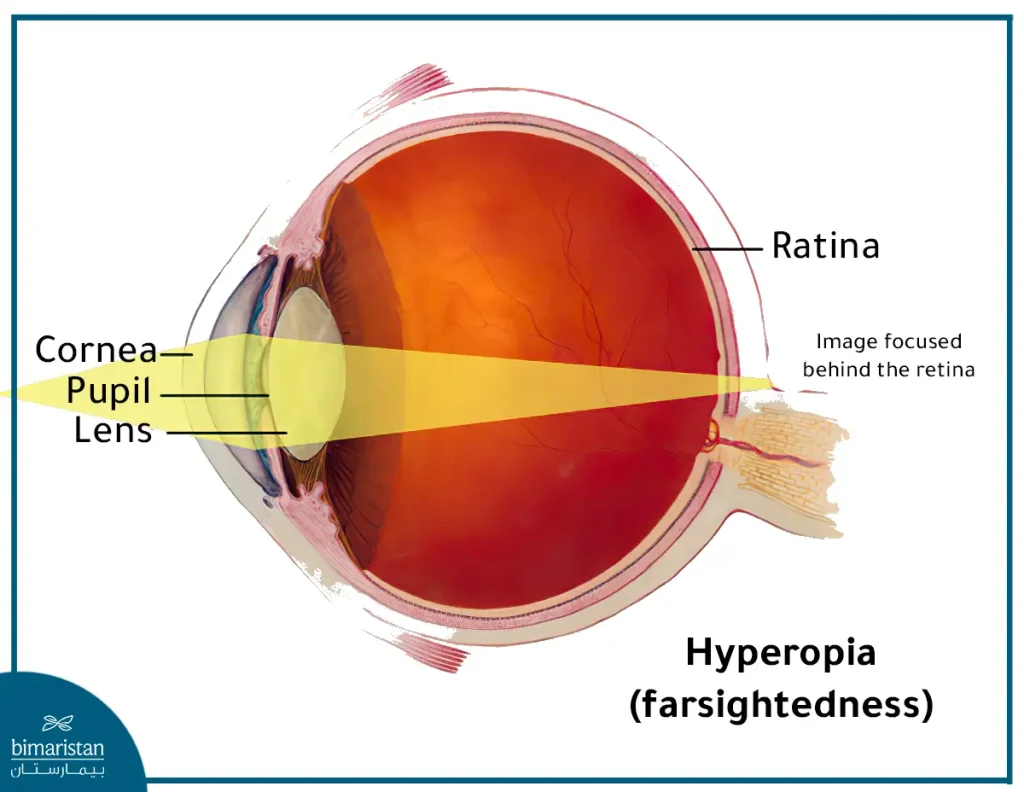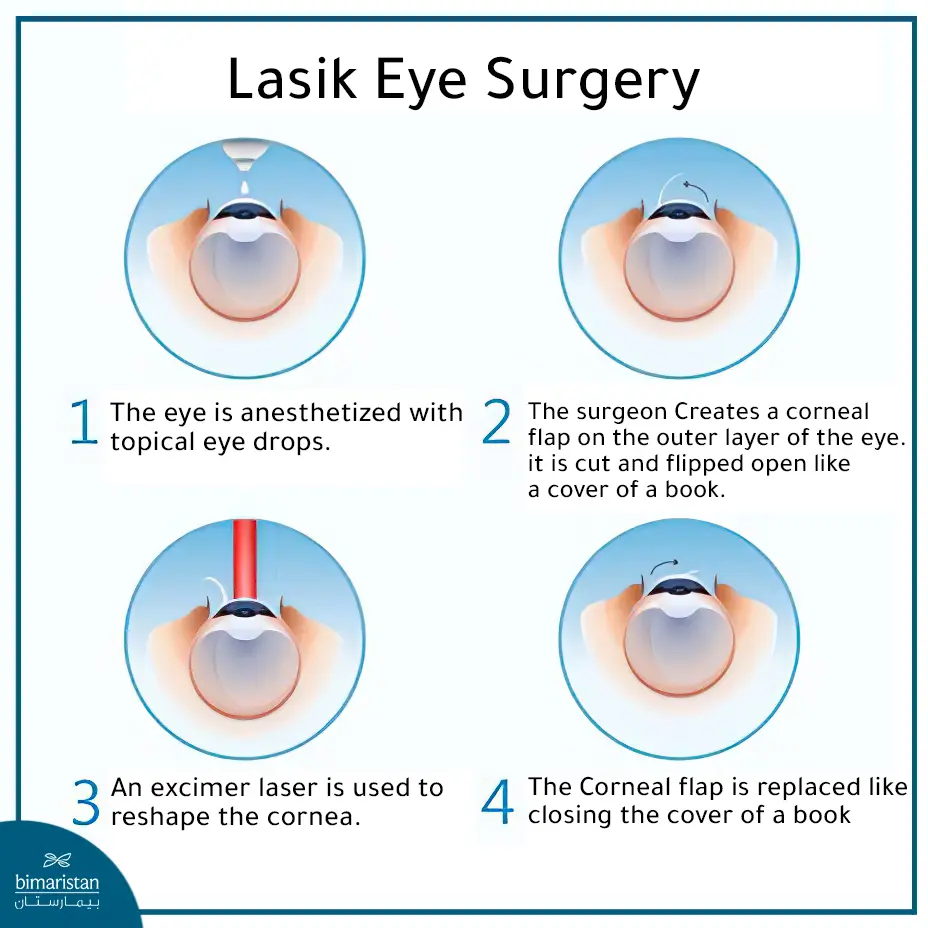Farsightedness (Hyperopia) affects approximately one-quarter of the world’s population. It is a visual problem that affects people of all ages. It does not only cause inconvenience but is essentially an error in the refractive power of the eye that partially impacts performance and quality of life. Statistics indicate that about 4-14% of children suffer from farsightedness, and this percentage may reach 20-25% by the age of 40.
Hyperopia can affect individuals of all ages. It can be detected in childhood, but it increases with age because the eye’s ability to adjust its focus diminishes over time.
What is farsightedness?
It is a common refractive error that affects vision, as the affected person is able to see distant objects clearly, while close objects may see them blurry.
This condition occurs when light entering the eye is focused behind the retina (a light-sensitive layer located at the back of the eyeball) rather than on it.
It is usually present from birth but is not noticed. The eye may adapt to compensate for the problem in youth, but it cannot with age.
The difference between hyperopia and myopia
hyperopia and myopia affect the ability to see clearly. The difference between them is whether you have difficulty seeing up close or far.
Farsightedness makes it difficult to see close objects, but the patient is able to see distant objects clearly. Conversely, nearsightedness makes it difficult to see distant objects, but the patient is able to see close objects clearly.
Farsightedness in children
Mild farsightedness in children is common, as the majority of children suffer from it because the eye is not fully developed. However, the eyes of most children are able to correct the mild condition, as the child’s eye has the ability to refract the light that enters the eye in a way that enables it to focus on the retina. The eye, thus increasing focus and eliminating blurry vision, and as children grow older, their eyes lengthen, so farsightedness can improve on its own.
Presbyopia
Presbyopia is part of normal aging, so doctors do not consider it a disease. It occurs when the lens of the eye becomes less flexible with age. It generally begins to develop around the age of forty and gets worse until the mid-sixties.
The person experiencing vision problems may find it difficult to read and may need to hold reading material at arm’s length. They may also experience headaches, pain, and eye strain.
Farsightedness measurements
The degree of refractive disorder, or the amount of correction required, is measured by what is called a “diopter.” The greater the degree of correction required, the greater the number of diopters. A negative diopter number indicates nearsightedness, while a positive diopter number indicates farsightedness. Diopters are also used as a measure of astigmatism as well.
Farsightedness can be detected during an eye examination, where the scale is given increments ranging from mild (less than +2.00 diopters) to severe (more than +6.00 diopters). In general, the most common condition is from +2 to +6 diopters, but it sometimes extends. To +20.0 diopters. This condition is not considered common, but it is dangerous and is accompanied by poor vision and strabismus.
Cause of farsightedness
Refractive disorders occur as a result of a change in the shape or length of the eye from normal or a defect in the curvature of the lens or cornea. In the case of farsightedness, the eyeball is too short, or there is not enough curvature in the lens to be able to focus on objects correctly, so light is focused at a point behind The retina instead of focusing directly on its surface.

Symptoms of farsightedness
The affected person may not notice any vision problems, but if the eye muscles work harder, some symptoms may appear, such as:
- Blurred vision, especially when looking at objects close to the eye
- Feeling tired when reading in the dark
- Double vision or difficulty reading
- Squinting when reading
- Mild eye pain
Children may have these symptoms but rub their eyes a lot or seem uninterested in reading.
Strabismus resulting from farsightedness
Strabismus is a condition in which the eyes do not line up with each other. In other words, one eye is directed in a different direction than the other eye.
Under normal circumstances, the six muscles that control eye movement work together and direct both eyes in the same direction. In strabismus, these muscles have problems controlling eye movement and cannot maintain a normal eye position.
Strabismus can sometimes result from untreated farsightedness. In an attempt to compensate for the blurring it causes, individuals (especially children) may round their eyes excessively, which can lead to strabismus.
When a person with farsightedness focuses too much on near objects, their eyes work harder to maintain clear vision. This extra effort can cause the eyes to turn inward (esotropia), outward (exotropia), upwards (esotropia), upper (hypotropia), or lower (esotropia), depending on the individual’s condition and the muscles involved.
Farsightedness treatment in Turkey
The goal of treatment is to help focus light on the retina by using corrective lenses or refractive surgery.
Corrective lenses
In young people, treatment is not always necessary because the crystalline lenses inside the eye are flexible enough to compensate for the condition. The patient may need prescription lenses to improve near vision, depending on the degree. This happens especially with age when the eye’s lens becomes less flexible.
Wearing prescription lenses is treated by resisting the lack of curvature of the cornea or the small size or length of the eye. Types of prescription lenses include:
- Medical glasses
- Contact lenses
Refractive surgery
Although most refractive surgeries are used to treat nearsightedness, they can also be used to treat mild to moderate farsightedness. These surgical treatments correct the problem by reshaping the curvature of the cornea through laser vision correction. Refractive surgery methods include:
Laser-assisted in situ keratomileusis (LASIK)
With this procedure, an eye surgeon makes a thin, hinged flap in the cornea and then uses a laser to adjust the curves of the cornea to correct farsightedness. Recovery from LASIK is usually faster and causes less discomfort than other corneal surgeries.
LASIK surgery is usually completed in 30 minutes or less. During the procedure, the patient lies on his back on a designated chair, and medication may be given to help relax.
After placing drops of an anesthetic in the eye, the doctor uses an instrument to hold the eyelids open. A suction ring is placed directly over the eye before a corneal flap is cut. This may cause a feeling of pressure on the eye and vision may be impaired.
The eye surgeon uses a small blade or laser to cut a small flap from the front of the eye. Folding the flap back allows access to the portion of the cornea for laser reshaping.
The eye surgeon reshapes parts of the cornea using a programmed laser. With each pulse of the laser beam, a small amount of corneal tissue is removed. After reshaping the cornea, the surgeon returns the flap to its place. The flap usually heals without stitches.
During surgery, the patient is asked to focus on a point of light. Staring at this light helps keep the eye still while the laser reshapes the cornea. If a patient needs LASIK in both eyes, doctors generally perform the procedure on the same day.

Laser-assisted subepithelial keratectomy (LASEK)
It is a procedure in which subepithelial keratoses are corrected with a laser, which highlights where the treatment is delivered directly under the corneal epithelium.
Two lasers are used in the LASIK process, one to create the flap and the other to reshape the cornea, while in this procedure we only need one laser.
During this procedure, no flap is created. Instead, the epithelium (outer layer of the cornea) is temporarily removed using alcohol and a very thin slice, as the alcohol helps dissolve the epithelial cells.
The flap is then positioned and slid over the cornea to move the cells to the side. This allows the surgeon to access deeper corneal tissue to permanently reshape the cornea. The excimer laser is then applied to the cornea to remove the tissue according to precise calculations that have been determined to be suitable for correcting the patient’s refractive error.
The epithelium slides back over the cornea to protect it during the healing process. Because this layer is only one layer thick, a contact lens is also used as a bandage to help protect and heal the cornea.
This procedure may be beneficial for those who play contact sports because they are at greater risk of flap dislocation.
Laser keratomileusis (PRK)
In PRK, the surgeon removes all of the epithelium and uses a laser to reshape the cornea. The epithelium is not replaced; instead, it will grow back naturally to conform to the new shape of the cornea.

Treatment of farsightedness in children
Mild cases of farsightedness may not require treatment in children, as their eyes can often adapt to compensate for the problem. However, if the child’s condition is not mild, eyeglasses or contact lenses can help, and surgery is rarely an option in some cases.
Treatment of farsightedness after forty
Most of the symptoms of farsightedness appear after the age of forty, as the eye’s lens becomes less flexible after aging, and this requires treatment. Treatment includes the same previous treatments, whether with corrective lenses or refractive surgery operations such as (LASIK, LASEK, PRK).
The cost of laser eye surgery for farsightedness in Turkey
The cost of treatment varies according to several factors, including the patient’s condition and financial ability. Treatment can be done with corrective lenses, whether with contact lenses or prescription glasses. This treatment is considered relatively cheap, but it is not considered a final treatment for farsightedness.
Surgical treatment options include LASIK, LASEK, and PRK, which cost 500 – 1500 US dollars. Bimaristan Medical Center offers the latest treatment methods at the hands of the most skilled surgeons in Turkey. We also offer a free consultation through our website, so do not hesitate to ask about your condition.
Anyone suffering from the symptoms of farsightedness should request a comprehensive eye examination. Through correct diagnosis and timely intervention, the effect of farsightedness can be greatly reduced, enhancing clarity of vision and overall quality of life. Bimaristan Medical Center offers a free consultation, so do not hesitate to contact us to choose the most appropriate treatment for you.
Sources :
- AMERICAN ACADEMY OF OPTHALMOLOGY
- KRAFF EYE INSTITUTE
- NIH